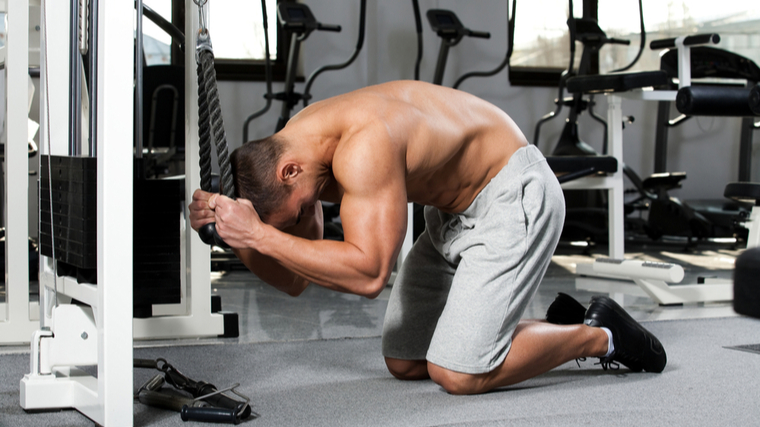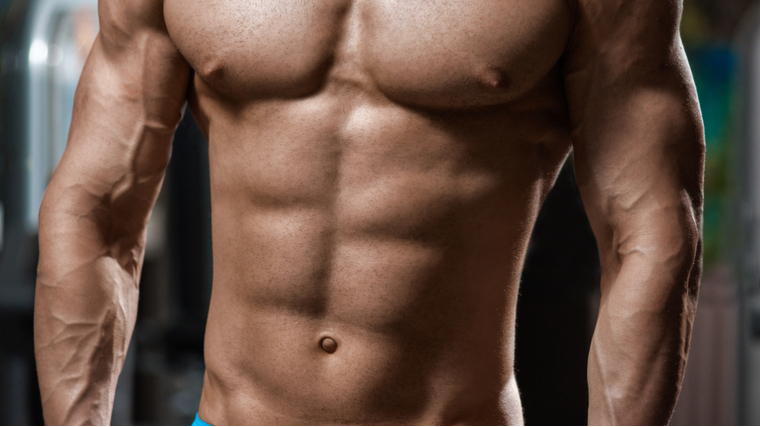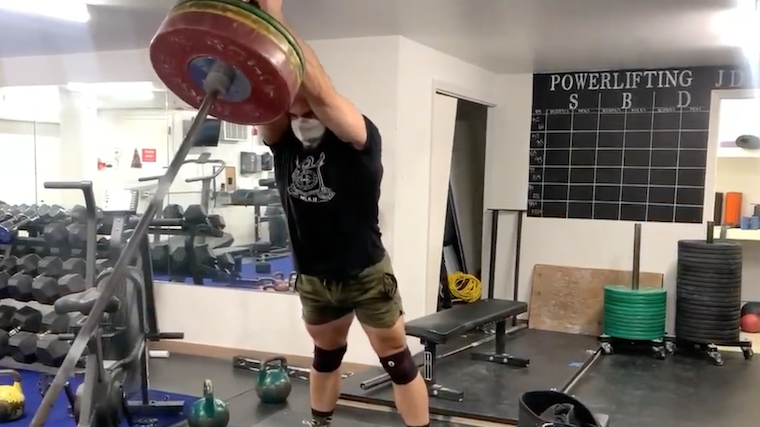Originally Posted At: https://breakingmuscle.com/feed/rss
There are typically two camps when it comes to ab training. There are those who are purely focused on strengthening their abs to hoist more weight and perform better as an athlete. And then some folks are mainly interested in whittling their middle a la Brad Pitt in Troy. But hear us now: You can have both ab definition and strength.
The first comes by way of a calculated diet for fat loss (mostly). Strength and muscle are forged in the gym, by selecting the right exercises and executing them with picture-perfect form. We can’t train for you, but we can point you in the right direction. And your journey to a stronger, leaner core should start with the cable crunch.
Arnold Schwarzenegger was a staunch supporter of the cable crunch, and though we could rest our case there, we’d be remiss if we failed to touch on its benefits: Optimal core tension from the cable pulley, a longer range of motion for a greater muscle-building stimulus, and did we mention Arnold loves the move?
Here’s everything you need to know to start doing cable crunches today.
- How to Do the Cable Crunch
- Cable Crunch Mistakes to Avoid
- Benefits of the Cable Crunch
- Muscles Worked by the Cable Crunch
- Who Should Do the Cable Crunch
- How to Program the Cable Crunch
- Cable Crunch Variations
- Cable Crunch Alternatives
- Frequently Asked Questions
How to Do the Cable Crunch
The cable crunch uses added resistance to train the abs, with a focus on their most contracted position. The movement is strict abdominal flexion with the aim of bringing your sternum and pelvis towards each other. During this exercise, your hips should remain stable and in a fixed position.
Step 1 — Get Into the Starting Position

Attach a rope to the high cable pulley and set the pulley at eye level. Take hold of the rope in each hand as you take about three steps back before kneeling on the ground. Kneel “tall” with your shins on the ground and your thighs vertical. Lean your torso slightly forward.
Pull the rope down until your elbows are roughly at a 90-degree angle to your torso and your hands are in front of your forehead. Hold the weight in this static position throughout the entire set.
Form Tip: Muscles in a static position are always stronger than when movement is involved, so maintaining a stable arm position should not be excessively fatiguing. If your arm, shoulder, or back muscles fatigue before your abs, reduce the weight. Performing the exercise consistently will build strength in the supporting muscles.
Step 2 — Perform the Crunch

Breathe in as you brace your core. Breathe out as you start to flex at the trunk and engage your rectus abdominis (ab muscles) to crunch your upper body forward and down. Your hips and arms should remain in a fixed position and stable as you fully contract the abs.
Don’t allow your hips or glutes to move backwards while crunching because it will reduce the exercise’s effectiveness.
Form Tip: Think about getting your face closer to your knees or your elbows to your thighs. Focus on curling your torso, not keeping your torso straight while bending at the hips.
Step 3 — Return to the Starting Position
As you begin to rise back up after reaching the bottom position, breathe in slowly and actively contract your spinal erectors (lower back) to “un-curl” and pull yourself up. Being mindful of this will assist in controlling the eccentric (lowering of the weight) and will allow you to lengthen the abdominals while keeping your hips stable. When your torso is upright again, repeat another rep.
Form Tip: Perform this phase of the exercise at a slower speed than the crunching phase, taking two or three seconds to reach the top position. The slower rep speed allows you to focus on maintaining technique and ensures strict form.
Cable Crunch Mistakes to Avoid
There are a few common mistakes that you will want to avoid to maximize the effectiveness of the cable crunch.
Most problems stem from recruiting the wrong muscles to move the weight or not putting your body in an optimal position to recruit the abs effectively.
Setting Your Hips Too Low
If your hips are too low when performing the cable crunch, you will rely on using your own body as a counterweight to move the resistance. Your hamstrings, glutes, and hip flexors will also be significantly involved in an exercise which should be primarily targeting your abdominals.
When you shift your hips back, you’re unable to achieve a full range of motion because your torso cannot fully contract and your torso cannot flex forward far enough.
Avoid It: Ensure movement comes from the spine, not the tailbone. Keep your hips high and locked in place in order to flex only from the trunk. Your glutes should not move closer to your feet during the exercise.
Taking the Wrong Grip
This may seem too simple, but your hand positioning plays an important role in leveraging your body from an effective position. Your hands and arms can also be a visual guide to make sure your hips are high enough.
Most people will pull the rope attachment down, resting their hands on their shoulders or upper chest. Pulling the weight “in” to your body can encourage you to sit back onto your heels rather than keeping your thighs up straight.
Avoid it: Keep the rope in front of your body with your arms bent. This encourages your shoulders, core, and entire upper body to be more engaged. Have the knuckles on both hands touching each other with your hands roughly at the height of your forehead. Your hands should remain in front of your face throughout each rep.
Benefits of the Cable Crunch
Not too many exercises require you to use the abs to directly move a weight. However, there are few better ways to train a muscle than against progressively overloaded resistance. The cable crunch allows you to challenge your abs not only by doing more reps, but by gradually lifting heavier each week.
This is exactly the type of training that builds powerful, great-looking muscles, whether it’s your abs, pecs, or legs.
More Core Strength
A strong set of abs can go a long way in improving your strength potential in many other lifts, such as your bench press, squat, and deadlift. The cable crunch directly trains the rectus abdominis which plays an important role in your ability to brace your core effectively. Stronger abs allow a more stable torso, which allows power to be transferred through to the working muscles.
Longer Range of Motion
The range of motion in any given exercise is an important factor in building muscle. The cable crunch provides a much longer range of motion in contrast to many other abdominal exercises like standard crunches or sit-ups. With a deep stretch in the top position and a full contraction at the bottom, the cable crunch works the abs through a significant range of motion.
Building Ab Muscle
You hopefully wouldn’t try to build arm size performing 50 reps of curls with no weight in your hand, but that’s how many people approach ab training. While the abs won’t grow inches thicker, they are made of muscle tissue which needs to be developed to look its best. The cable crunch trains your abs against resistance, which stimulates muscle growth and builds a good-looking set of abs.
Muscles Worked by the Cable Crunch
The cable crunch is an abdominal flexion exercise, with no twisting or rotating. This makes it an ideal exercise for zeroing in on the primary ab muscle — the rectus abdominis.

When done correctly, it produces a serious contraction along the entire ab muscle.
Rectus Abdominis
The rectus abdominis attaches the sternum, the connective tissue of the ribs, and the pelvis. Its primary function is flexion of the spine, or flexing the trunk forward. It also contributes to postural support for your entire upper body.
Hip Flexors
The hip flexors are a series of small muscles found at the top of the thigh around the hip bones, appropriately. They connect the pelvis to the lower back and are responsible for bringing the legs closer to the chest. During the cable crunch, the hip flexors should not be significantly activated unless the hips move improperly during the exercise.
Who Should Do the Cable Crunch
The cable crunch can help any lifter improve their ability to tense and contract their abs. This can only help to sculpt a nice-looking set of abs (once you remove some body fat to reveal the ab muscles), but it also provides a functional benefit improving your ability to perform a variety of exercises.
Training For Strength
Improving your abdominal strength builds a strong core, which is essential for moving big weights in any lift. If you’re losing your squats and deads by falling forwards or not bracing hard enough during presses, cable crunches are an useful assistance movement to support total-body strength.
Training For Muscle
If you are training purely for aesthetic purposes, the cable crunch is just as useful to you as lat pulldowns, triceps pressdowns, or any other targeted cable exercise. The cable pulley is ideal for constant tension, slightly higher reps, and extended time under tension which can provide your abs with a greater stimulation of muscle growth. (1)
How to Program the Cable Crunch
The cable crunch can be programmed in a number of different ways to benefit your specific training objective.
Moderate Weight, Moderate Reps
Performing the cable crunch for three to four sets of eight to 12 reps will provide the most bang for your muscle-building buck. Focus on the strength of your contractions and progressively overload the exercise just like you would for your primary strength lifts.
A steady and controlled tempo will be best-suited, taking your time to feel every inch of your abdominal muscles contracting and lengthening throughout each rep.
Low Weight, High Reps
Performing the cable crunch for two to three sets of 13 reps or more will allow you to add a greater amount of volume to your ab training and will be most useful at the end of your workout to finish off your abs.
The emphasis is on maintaining tension on the abdominals and providing a continual contraction, which leads to the feeling of being “pumped.” Perform reps steadily without pausing at any point in the movement. Take two seconds when you return to the starting position, no pause at the top, take one second to contract the abs, and have no pause at the bottom. This will complete one rep at 2-0-1-0 tempo.
Cable Crunch Variations
Here are two effective variations which can be switched out in place of, or in addition to, the standard cable crunch depending on your specific needs and overall workout program.
Standing Cable Crunch
The standing cable crunch can improve your strength and stability throughout your core, while also allowing for a great range of motion. However, that also comes with an increase in the difficulty of achieving maximum contraction in the abs.
The movement is performed by closing the gap between your sternum and pelvis. Avoid thinking about bending straight down. To assist with good form, think about bringing your hips forward as you crunch and looking at your belt buckle.
Machine Crunch
The machine crunch can make it easier to target the abdominal muscles because the machine puts you in a good position. In this variation, you sit upright and the machine will assist in flexing your torso, with your chest and thighs meeting in the middle.
This exercise variation can assist you in developing a greater mind-muscle connection since you can focus on feeling the abs instead of coordinating movement during the exercise. An improved mind-muscle connection can then translate into feeling the muscle working even more effectively during more difficult exercises like the cable crunch.
Cable Crunch Alternatives
In order to be a successful exercise alternative, the primary muscle needs to be the rectus abdominis. The movement needs to involve flexing the spine with a full contraction of the abdominals, and without twisting or rotating the torso.
Floor Crunch
Floor crunches are the most simple alternative that can be used in place of the cable crunch. All you need is a floor and you are good to go.
It’s easy to perform and has an extremely short range of motion. This exercise is most often associated with lifters who are new to training and learning how to perform the fundamentals.
Sit-Up
Sit-ups are a very similar exercise to crunches, but provide a longer range of motion (similar to the cable crunch), which makes them relatively more challenging.
This exercise can be progressively overloaded with the use of a weight held to your chest or over your head throughout each rep.
Decline Bench Sit-Up
The closest exercise alternative to the cable crunch is the decline bench sit-up due to the significant range of motion and spinal flexion needed to perform the movement. All you need is a bench set to a declined angle.
You can make the exercise more challenging by raising the angle of the bench and/or by adding resistance using a dumbbell or weight plate.
FAQs
Are cable crunches effective at shredding abs?
Cable crunches are effective at building a strong set of abs and they provide a direct muscle growth stimulus. However, doing cable crunches to get shredded won’t work. No ab exercise can help with that.
The only way to reveal a defined set of abs is to focus on your daily energy balance and make sure that you consistently stay within a caloric deficit. This is generally achieved by a reduction in total calories and/or an increase in your energy expenditure.
Can I injure myself when performing cable crunches?
Performing any exercise with incorrect technique can increase your risk of injury. The cable crunch isn’t as high-risk as the deadlift or back squat, but performing it with poor form can lead to some problems.
If you are not rounding your back properly and fully flexing your abs in the bottom position, you may prevent your rectus abdominis muscles from contracting effectively which can restrict you from training through a full range of motion and will interrupt progress. Involving your hip flexors by excessively sitting back or sitting down can aggravate lower back issues, because the hip flexors are connected to the lumbar spine.
Get Down and Crunch
The cable crunch is one of the few exercises requiring the abs to work against resistance instead of being performed with just your bodyweight. This makes the exercise a high priority for building stronger, better developed abs. It’s time to start practicing this powerful movement and fit it into your next ab workout.
References
- Burd NA, Andrews RJ, West DW, et al. Muscle time under tension during resistance exercise stimulates differential muscle protein sub-fractional synthetic responses in men. J Physiol. 2012;590(2):351-362. doi:10.1113/jphysiol.2011.221200
Featured Image: Skydive Erick / Shutterstock
The post How to Do the Cable Crunch for Ab Strength and Size appeared first on Breaking Muscle.

 Creatine is an extremely popular supplement with thousands of studies attesting to its effectiveness in humans. It works well in athletes, older people,
Creatine is an extremely popular supplement with thousands of studies attesting to its effectiveness in humans. It works well in athletes, older people, 
 and one scoop of glutamine in water
and one scoop of glutamine in water  Greetings, readers! I’ve been so heartened over the past year with the great response to the book Two Meals A Day, which we launched in March, 2021. It’s particularly interesting to note how many new people have been welcomed into the fold of ancestral living via the portal of a mainstream-appeal book about healthy living. My writing partner Brad Kearns and I intended for this book to reach a broader audience outside the existing spheres of Primal/paleo and keto, so we placed the focus on ditching processed foods, emphasizing nutrient-dense ancestral foods, and eating less frequently—pretty simple! We’ve received great comments from readers who then discovered Marks Daily Apple, the many Primal Blueprint book titles, and generally became further captivated by Primal living.
Greetings, readers! I’ve been so heartened over the past year with the great response to the book Two Meals A Day, which we launched in March, 2021. It’s particularly interesting to note how many new people have been welcomed into the fold of ancestral living via the portal of a mainstream-appeal book about healthy living. My writing partner Brad Kearns and I intended for this book to reach a broader audience outside the existing spheres of Primal/paleo and keto, so we placed the focus on ditching processed foods, emphasizing nutrient-dense ancestral foods, and eating less frequently—pretty simple! We’ve received great comments from readers who then discovered Marks Daily Apple, the many Primal Blueprint book titles, and generally became further captivated by Primal living.

 For now classes are 6pm and 640pm at 2840 Wildwood st in the Boise Cloggers studio.
Book your class NOW!
click this ==>
For now classes are 6pm and 640pm at 2840 Wildwood st in the Boise Cloggers studio.
Book your class NOW!
click this ==>








